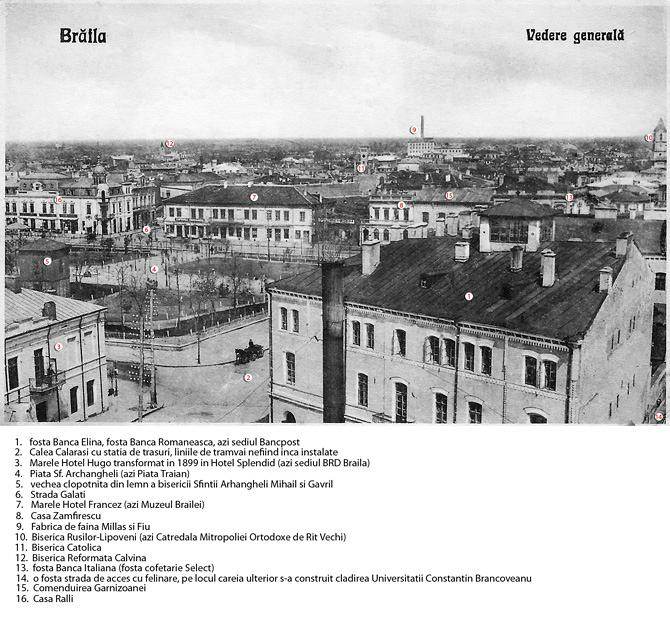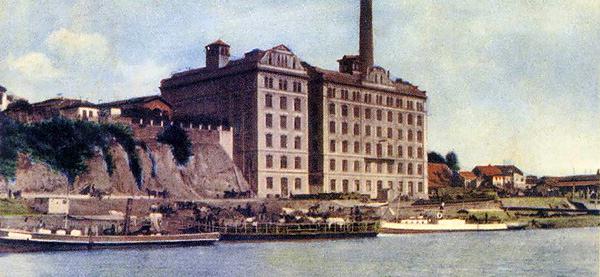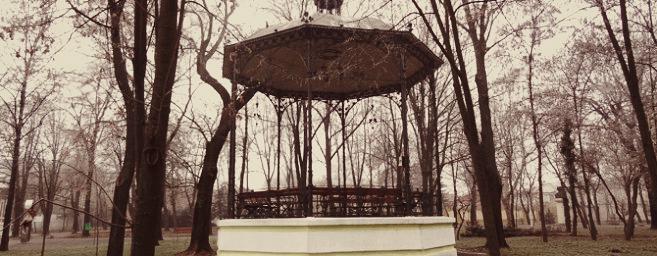
Historical data
The flour mill Millas & Son
The mill was built in 1879 between Unirii, Galati and Carol streets, in Braila, Romania.
In 1904 the building was sold to the Land Credit Bucharest company.
In 1920 the building was destroyed by fire. Today there is another building in the same place.
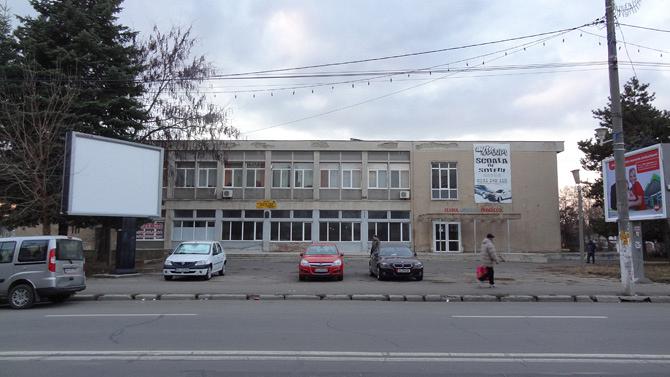
Photo of 1906-1909
1. Former Bank Elina, Former Bank Romaneasca, today Bank Bancpost.
2. Carriage in Calarasi street. Tram lines were constructed later.
3. The Hugo Hotel changed into the Splendid Hotel in 1899.
4. Sf. Archangheli square, called Train square nowadays.
5. The old wooden church of Sfinitii Archangeli Mihail and Gavriil.
6. Galati street.
7. The Francez Hotel – Braila Museum nowadays.
8. Zamfirescu residence.
9. Millas & Son Flour Mill.
10. Rusilor-Lipoveni church, now Rit Vechi Catredala Mitropoliei Ortodoxe.
11. Catolica church.
12. Reformata Calvina church.
13. Former Bank Italiana (former Cafe Select).
14. Former access road with street lights.
15. Comenduirea Garnizoanei.
16. Ralli Residence.
Maps
You can see maps of the area here and here.
Braila, Romania
Braila is a port on the Danube river, in north-eastern Wallachia, Romania which was probably founded in the late 14th century. Braila is located very close to another major port in the region, Galatsi. Its privileged position made the city an extremely important shipping and commercial center. In 1540 it was conquered by the Ottomans, who fortified it and established a strong guard.
In the early 19th century, Turks, Romanians, and many Greeks, especially merchants, Armenians and Jews lived in the city. Since the early 1830’s, many more Greeks, basically traders and craftsmen, settled down in Braila, and quickly dominated the economic life of the city.
The number of Greeks in the second half of the 19th century, was about 5,000, representing 10% of the city residents. In this time, Braila was the largest port in the country and an important industrial center.
The Greek people dominated the field of flour industry. We should mention that four out of the five modern mills in the city, belonged to greek families: (The Galiatsatou brothers, John Millas and Son, Christophoratou etc). The Greek mills were among the most modernized in Romania and in contrast to the flour mills of Bucharest, they were directed to exports. Until the eve of the Second World War, there had been established some other units, such as Panayis Violatos’ flour mill and that of Lykiardopoulos-Valerianos, the largest in Romania.
Shipping
Throughout the Ottoman period, Braila was a notable commercial center, mainly as a port exporting cereals and other agricultural products. In 1837, the number of ships that had sailed to the port reached 448. The ships under Greek flag had the strongest presence in the commerce. A. Petalas, Th. Faraggas and I. Lykiardopoulos were among the most important Greek merchants.
The strong growth the export trade experienced in cereals from the mid 19th century, and the funds collected by Greek merchants and shipowners, contributed to the transition from sail to steam navigation. This happened first in Braila, and the aouter Danube region as well as the Greek communities in Azov.
Some of the most important ship owners from Cephalonia and Ithaca, like Stathatos brothers, John Theophilatos, E. Vlassopoulos, and the Empirikos family from Andros island, taking advandage of their close relations with merchant families especially from Chios, such as (Sekiaris and Rodokanakis families), formed the “Ionian Network” and succeeded, in acquiring many steamboats and in imposing a dominant position in this field, in the late 19th century.
The main activity of the greek community of Braila, was, however, the riverboats. Some of the greatest owners of barges (slepion) were Manuel G. Chrysovelonis, Stathatos Brothers, Othon Stathatos and many others.
Massive flight of Greeks in 1950-1951
In 1950-1951, we have the decline of the Greek community. Approximately 50% of the Greek people who lived in Braila decided to leave the city because of the change in the political status. Some of them moved to Greece, others to Australia or America, leaving all their fortune behind. One of the consequences was the definite closure of the Greek schools in the area.
Panagis Violatos’ flour mill
Panagis Violatos’ flour mill was built in 1898 and it was the largest steam – powered flour mill in Eastern Europe. Millas and Violatos were partners since 1889 and they were the main suppliers of flour to England.
In 1891 Violatos purchased Borghetti Mills and then Lambridini Mills and started producing four qualities of flour.
In 1892 Violatos alone achieved the most ambitious industrial project in Romania.
Unfortunately, an unfair competition started when Violatos began to attract employees of the Millas Company, offering them higher salaries. He even tried to do the same with John Valerianos, who was Millas’ nephew.
Violatos Brothers’ Mill is one of the most important monuments of industrial architecture, and it was certified since 1897. Built on the shore of the Danube river, near the port of Braila, it competed in equipment and productivity with the largest international factories. It employed 70 workers and Its machines came from Braunschweig, Germany, had a capacity of producing 400-500 tons per 24-hours. In 1924, a railway from the harbor to the mill gave access to the national rail network. The production of Violatos’ Mill reached not only the internal market, but also foreign countries such as Egypt, Greece and Turkey.
In the 1940’s the company declared bankruptcy.
Valerianos-Lykiardopoulos flour mill
Valerianos-Lykiardopoulos flour mill was built in 1911-1912.
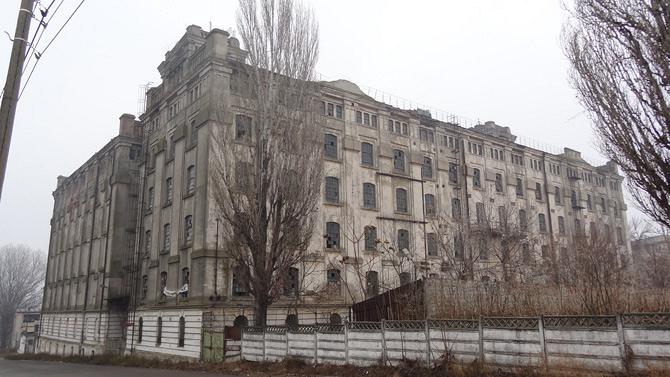
Called “the automatic flour factory” it had a productivity of 24 wagons of wheat in 24 hours and managed to get an even bigger production than Panagis Violatos’ mill.
In the beginning it was the property of the Lykiardopoulos brothers but after the first world war, the elder brother Spyros was the only shareholder.
After the marriage of Valerianos with a sister of Spyros Lykiardopoulos, Valerianos became a shareholder and the mill was called Valerianos-Lykiardopoulos.
In 1948 the mill was nationalized and continued to operate under the name Nicolae Baltseskou. The mill continued to operate until the 90’s. It is currently under maintenance.
Evangelismos Greek – Orthodox Church
Architectural monument
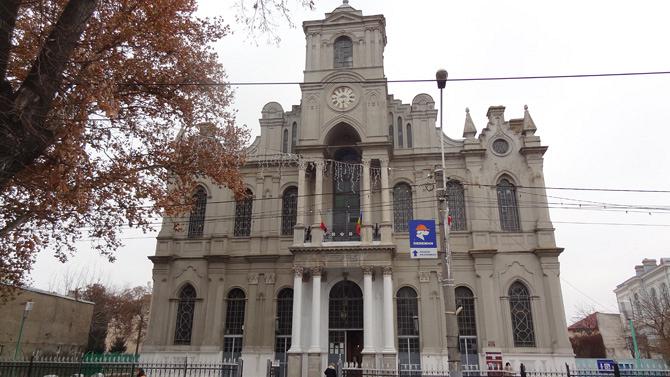
Owned by the Greek community, the Evangelismos church was built between 1863-1872 by the architect Abraham Ioannidis, originating from Prussa, Asia Minor. He himself supervised the construction of the church by Italian builders and craftsmen.
The Church has the form of a cross, with two domes and its dominant style is Greek – Byzantine, with Gothic and Renaissance details.
The murals at the central dome were painted by Gh. Tattarescu in 1872. Constantine Livadas-Liokis from Cephalonia painted another part of the church in 1901 and finally, in 1945 – 46 Velissarios completed the murals.
The Vallianos Family
The Vallianos family from Ceramies, Livathous, Cephalonia, excelled in maritime and commercial activities during the 18th and 19th century, following the maritime tradition of Cephalonia. Vallianos’ family activities are recorded in the archives of many Western European ports. There, we can find many masters called Vallianos (Andrew, Alexander, Gerasimos, Rokos, Theodoros, Antonios), even though we don’t know their relationship with the Vallianos family of Romania.
During the heyday of the family (in the second half of the 19th century), they created the House of Vallianos Brothers in the area of the Black Sea, based in Taganrog (Taigkanrok) of the Azov, and later with agencies in London and Marseilles.
The father of the company’s founders was Athanasios Vallianos, who was probably born in mid 1770’s. Athanasios and his wife Fronia had eight children: Santina, Spiros, Nikolaos, Metaxas, Marinos (1808-1896), Panayis (1814-1902), Andreas (1827-1889) and Maria. Marinos, Panagis and Andrew were the major fraternal trio who created the Vallianos Brothers House.
Two years after the Crimean War in 1858, Panagis Vallianos settled down to London, the most important economic center of that time. The opening of a London branch was decisive and marked the internationalization of the firm. The new agency called Vagliano Bros was at 19, Broad Street in the City of London. Panayis Vallianos spent there the next 44 years of his life, until his death in 1902.
Panayis Vallianos did not represent only his own interests but also, those of the Theophilatos and the Millas families, who were merchants of cereals in the Danube area. After he had gained access to the Baltic Exchange Center, the main international grain market, and due to the strong reputation of his company, he managed, to open an account at the Bank of England. Besides, in the early 1860’s Panagis was still a subject of the British Empire.
The Lykiardopoulos Family
The origin of the family from Korianna, Livathous in Argostoli of Cephalonia, is not a coincidence. The area of Livathous is known as the birthplace of most of the Cephalonean sailors. Moreover, the island is the most important center for the development of the Ionian and the Greek shipping in general. Especially Livathous in southern Cephalonia, was the birthplace of very many and very important ship owners, such as the following families: Fokas Valsamakis, Kalligas, Inglessis, Kouppas, Svoronos Vergotis, Vallianos families. Many of them, like the Lykiardopoulos family, are still active today.
The New Era: Transition in shipping
In the late 19th century, especially after 1895, many members of the greek community of the Danube and the Black Sea area, decided to move their businesses to new, more important international shipping centers such as London and Piraeus. As a result, they were operating with the standards of the most important ship owners of their times and not only as merchants oriented to the marketing of a particular cargo such as cereals. In 1897 Lykiardopoulos Brothers were among the first, who settled in Piraeus entering the shipping activities with the first steamboat. This attempt was funded by members of the Ionian Network and, more specifically, by the strong Vallianos family. (The two families were relatives). Therefore, Nikolaos Dionysiou Lykiardopoulos (1866-1963), who stood out from the rest of the family and created a brilliant career in shipping, was funded by his wife’s uncle, Athanasios Vallianos and he managed to establish in a relatively short period, a remarkable fleet of 6 steamboats and a total tonnage of 14,440 GT. Nikolas Lykiardopoulos established his shipping Agency in London in 1901, while the evolution of the greek shipping buisiness was impressive in the first decades of the 20th century. In 1938 the Group of Nikolas Lykiardopoulos held a total tonnage of 36,285 GT and was classified among the most important Greek shipping groups, such as those of the Kouloukountis family from Kasos, the Goulandris family from Andros, the Livanos family from Chios, the Nomikos family from Santorini, etc. In 1917, Nikolas Lykiardopoulos actively participated in the establishment of the Union of Greek Shipowners, which he represented continuously as chairman from 1950 until 1960.
The Lykiardopoulos Family in Romania
However, apart from southern Russia and Greece, the presence of the Lykiardopoulos family was notable in the Danube, the prime area of activity of the Ionian merchants and ship owners in the 19th century.
In 1837, in the archives of the port of Braila, there was already listed the name of a certain Ion Licherdopulu (obviously John Lykiardopoulos), British citizen of Greek nationality, born in Cephalonia. Lykiardopoulos was one of the leading merchants of the city.
Other memebers of Lykiardopoulos family were recorded in Tulcea, another Danube port in the Ottoman province of Dobrudja. The founder of the family, Panagiotis Lykiardopoulos, from Cephalonia, moved in early 1830’s, during the development of the port, along with his three sons. He quickly became one of the major merchants of cereals in the city. The members of the family were constantly involved in trade and real estate business until the mid-war years.
It is worth mentioning that many of the descendants of Panagiotis Lykiardopoulos married members of other major Cefallonian families of Tulcea and Braila. Thus, Catherine Lykiardopoulou, the granddaughter of Panagiotis married Michael Pappadatos, son of one of the richest families in town. Another granddaughter, Pigi, married Demetrios Millas, the owner of one of the largest flour mills in Romania, located in Braila. This marriage, led to the moving of other family members in Braila and to the establishment in 1912, of the “Lykiardopoulos & Valerianos Flour Industry”, which was the largest one throughout Romania.
Elias Lykiardopoulos, emigrated to Tulcea in the Danube area in Romania, where he developed successful commercial and maritime activities. These activities were continued by his sons, Spyridon (1872-1946), Theodore and Vassilios (1884-1945), who had studied in Switzerland. The Lykiardopoulos brothers invested their money in a large flour mill in Braila, in collaboration with the Valerianos brothers who were successful businessmen. They also invested their money in a large number of barges (cargo ships) and in 1908 they acquired their first steamship, named “Brotherhood”, which was then sold at a high price in 1915.
Nicholas Lykiardopoulos began his career in sailboats at the age of thirteen as a sailor and then, he worked on Vallianos’ ships under the orders of his uncle, Fotis Lykiardopoulos, who was a master. In 1891 he married Catherine P. Rosolymou, a daughter of an important commercial and naval family from Cephalonia. In 1897, with a loan from Vallianos family, he bought his first steamboat, the “Helen Millas” and he managed to take advantage of the high freight of the year 1900. By 1914, through financing from his wife’s uncle, Athanasios Vallianos, Nikolas Lykiardopoulos managed to acquire the impressive number of six steamers, three of which were newly built. This achievement, ranked him among the top ten Greek ship owners, on the eve of the First World War.
